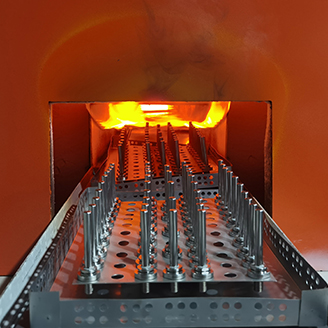What is brazing? What is the difference between soft brazing and hard brazing?
Nov. 29, 2023
01. Characteristics and applications of brazing
Brazing uses an alloy with a lower melting point than the base metal as the filler metal. When heated, the filler metal melts, fills and remains in the joint gap by wetting and capillary action, while the base metal is in a solid state, relying on the liquid filler metal and solid parent material. The mutual diffusion between materials forms a brazed joint. Brazing has little impact on the physical and chemical properties of the base metal, has small welding stress and deformation, can weld dissimilar metals with large differences in performance, can complete multiple welds at the same time, has a beautiful and neat joint appearance, simple equipment, and low production investment. However, the strength of the brazed joint is low and the heat resistance is poor.
Application: Carbide cutting tools, drilling bits, bicycle frames, heat exchangers, conduits and various containers, etc.; in the manufacturing of microwave waveguides, electron tubes and electronic vacuum devices, brazing is even the only possible connection method.
02. Brazing and flux
Filler metal is the filler metal used to form a brazed joint, and the quality of the brazed joint depends largely on the filler metal. The brazing material should have a suitable melting point, good wettability and gap-filling ability, and can diffuse with the base metal. It should also have certain mechanical properties and physical and chemical properties to meet the performance requirements of the joint. According to the different melting points of solder, soldering is divided into two categories: soft soldering and hard soldering.
Soft brazing
Soldering where the melting point of the solder is lower than 450°C is called soft soldering. The commonly used solder is tin-lead solder. It has good wettability and conductivity and is widely used in electronic products, electrical appliances and auto parts. The joint strength of soft soldering is generally 60~140MPa.
Hard brazing
Brazing with a solder melting point higher than 450°C is called brazing. Commonly used solders are brass solder and silver-based solder. Joints using silver-based solder have high strength, conductivity and corrosion resistance. The melting point of the solder is low and the processability is good. However, the price of the solder is high. It is mostly used for welding parts with higher requirements. Generally, there are many welding parts. Use brass solder. Brazing is mostly used for brazing steel and copper alloy workpieces that are subject to greater stress, as well as tools. The joint strength of brazing is 200~490MPa.
03. Brazing heating method
Almost all heating sources can be used as brazing heat sources, and brazing is classified accordingly.
(1) Flame brazing: Heating with gas flame, used for brazing carbon steel, stainless steel, cemented carbide, cast iron, copper and copper alloys, aluminum and aluminum alloys.
(2) Induction brazing: Resistance heating welding parts that use an alternating magnetic field to generate induced current in parts. It is used for welding parts with symmetrical shapes, especially for brazing of pipe shafts.
(3) Dip brazing: The weldment is partially or completely immersed in the molten salt mixture or solder melt, and the brazing process is realized by relying on the heat of these liquid media. It is characterized by rapid heating, uniform temperature, and smooth welding. Small deformation.
(4) Brazing in the furnace: The resistance furnace is used to heat the weldment. The resistance furnace can protect the weldment by vacuuming or using reducing gas or inert gas.

In addition, there are soldering iron soldering, resistance soldering, diffusion soldering, infrared soldering, reaction soldering, electron beam soldering, laser soldering, etc.
Brazing can be used to weld carbon steel, stainless steel, high-temperature alloys, aluminum, copper and other metal materials, and can also connect dissimilar metals, metals and non-metals. It is suitable for welding joints with low load capacity or working at normal temperature. It is especially suitable for precision, micro and complex multi-brazing welding parts.









